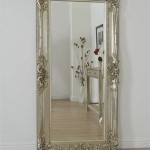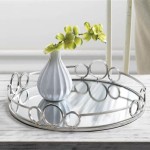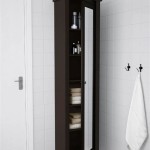Best Way to Make a Mirror Frame
Creating a mirror frame can be a rewarding do-it-yourself project, adding a personalized touch to home decor. The optimal method for constructing a mirror frame depends on factors such as desired aesthetic, skill level, available tools, and budget. There are several approaches, each with its own set of advantages and disadvantages. This article will explore some of the most effective methods for crafting a mirror frame, focusing on considerations for material selection, construction techniques, and finishing touches.
Selecting the Right Material
The material of choice significantly impacts the overall look, durability, and cost of the mirror frame. Wood remains a popular option due to its versatility, availability, and ease of workability. Different wood types offer distinct characteristics: softwood like pine is economical and easy to cut, while hardwoods like oak and maple provide superior strength and a more refined appearance. Reclaimed wood offers an eco-friendly and rustic alternative, adding character to the frame.
Beyond wood, other materials are also suitable for mirror frames. Metal, such as aluminum or steel, offers a sleek, contemporary aesthetic and is resistant to moisture damage. However, metalworking often requires specialized tools and skills. Polymer-based materials, including PVC and acrylic, provide water resistance and design flexibility, allowing for intricate shapes and vibrant colors. These materials are often lighter than wood or metal, simplifying installation. The specific aesthetic goals and environmental factors will guide the best material selection for the mirror frame.
Another material possibility is using pre-made moulding. This option allows for a variety of styles and finishes to be achieved quickly, as the moulding only needs to be cut to size and joined together. This simplifies the construction process and significantly reduces the amount of woodworking or metalworking skills required.
Effective Construction Techniques
Once a material is selected, the construction phase begins. Accurate measurements are critical for ensuring a snug fit for the mirror. The inner dimensions of the frame should precisely match the mirror’s dimensions, or be slightly larger to allow for expansion and contraction. The outer dimensions are dictated by the desired width and thickness of the frame.
One common construction technique is the use of mitered corners. Mitered corners, where the frame pieces are cut at a 45-degree angle and joined, create a clean, professional look. Accuracy is paramount when cutting mitered corners; a miter saw or a miter box with a hand saw can be used, but precision is essential for seamless joints. Glue and clamps are then used to secure the mitered corners together, ensuring a strong bond. For added strength, dowels or biscuits can be inserted into the joints to provide mechanical reinforcement.
Another approach involves butt joints, where the frame pieces are joined end-to-end. While simpler to execute than mitered corners, butt joints are inherently weaker. To strengthen butt joints, screws, nails, or pocket-hole joinery can be employed. Pocket-hole joinery involves drilling angled holes into one frame piece, allowing screws to be driven into the adjacent piece. This technique creates a strong, concealed joint. Reinforcement with corner brackets or metal plates can further enhance the stability of butt-jointed frames.
For metal frames, welding is a common joining method. Welding requires specialized equipment and expertise, but it creates a strong, permanent bond. Alternatively, metal frame pieces can be joined using screws or rivets. When working with polymer-based materials, solvent welding or adhesives specifically designed for plastics can be used to create strong, seamless joints.
Regardless of the joining method, consistent clamping is essential during the adhesive curing process. Clamping pressure ensures uniform contact between mating surfaces, maximizing the strength of the bond. Corner clamps are particularly useful for mitered corners, while bar clamps can be used for longer frame sides. The type of glue or adhesive used for your project should be considered when determining the clamping time required.
Achieving the Desired Finish
The final stage involves applying a finish to protect the frame and enhance its appearance. The choice of finish depends on the material and the desired aesthetic. For wooden frames, options include staining, painting, varnishing, and applying oil-based finishes.
Staining allows the natural grain of the wood to show through, while adding color and depth. The stain is applied evenly and then wiped off to control the intensity of the color. Multiple coats of stain can be applied to achieve a richer, deeper tone. After staining, a clear topcoat, such as varnish or lacquer, can be applied to protect the stain and provide a durable, glossy finish.
Painting offers a wider range of color options and provides a more opaque finish. Before painting, the wood should be primed to create a smooth, uniform surface for the paint to adhere to. Several coats of paint may be necessary to achieve full coverage. When selecting paint, consider factors such as durability, water resistance, and sheen. Latex paints are easy to clean and environmentally friendly, while oil-based paints offer superior durability and a smoother finish.
Oil-based finishes, such as tung oil or linseed oil, penetrate the wood, enhancing its natural beauty and providing a protective layer. Oil finishes are easy to apply and maintain, but they may require periodic reapplication. For metal frames, options include powder coating, painting with metal-specific paints, or applying a clear coat to protect the bare metal from corrosion.
Polymer-based frames can be painted with acrylic paints or spray-painted with specialized plastic paints. Before painting, the surface should be cleaned and primed to ensure proper adhesion. Some polymer materials may require special surface preparation techniques, such as sanding or etching, to promote paint adhesion.
Before applying any finish, the frame should be properly prepared. This includes sanding the surface smooth, filling any holes or imperfections with wood filler, and cleaning the surface to remove dust and debris. Applying the finish in thin, even coats will help to prevent drips and runs. Allow each coat to dry completely before applying the next. Sanding lightly between coats can further enhance the smoothness of the finish.
The method of securing the mirror within the frame must also be considered during the finishing phase. Small brads or flexible tabs can be used to hold the mirror in place. Backing material, such as cardboard or foam board, can be inserted behind the mirror to provide additional support and prevent it from shifting. The choice of securing method depends on the size and weight of the mirror, as well as the design of the frame.
The best approach for crafting a mirror frame is multifaceted, involving careful material selection, precise construction techniques, and meticulous finishing. Each stage influences the final product's appearance, longevity, and functionality. By considering the project's specific requirements and personal preferences, a suitable and well-executed mirror frame can be achieved.

How To Make A Diy Bathroom Mirror Frame Thediyplan

3 Ways To Frame A Mirror Wikihow

How To Make A Simple Mirror Frame With Wood Upgrade An Old

How To Build A Mirror Frame Sunshine And Rainy Days

Diy Bathroom Mirror Frame For Under 10 O Hayley Blog

Diy Farmhouse Wood Frame Mirror She Gave It A Go

How To Build A Mirror Frame Simple Woodworking

How To Make A Simple Mirror Frame With Wood Upgrade An Old

Diy Stick On Mirror Frame Sawdust Sisters

Framed Floor Mirror Love Grows Wild








